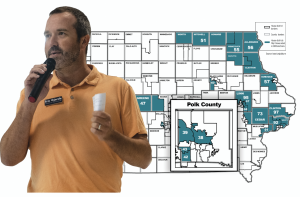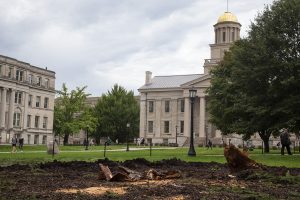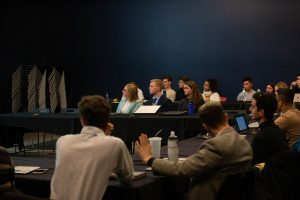UISG funds prairie restoration project
At the University of Iowa Student Government’s centennial meeting Tuesday evening, the University of Iowa Prairie Restoration Project received funding to complete the final steps before planting the prairie.
University of Iowa Student Government Senators listen to a presentation during a meeting in the IMU on Tuesday, Nov. 12, 2019.
November 12, 2019
University of Iowa Student Government secured funding for a new UI campus prairie restoration — a project that’s been nearly two years in the making.
UISG passed a resolution Tuesday to allocate $1,300 to the UI Prairie Restoration Project. The money will be used to buy seeds that will diversify the prairie on the campus cross country course.
Megan Lenss, a third-year UI student, has been at the forefront of this project since its beginning. She said the Prairie Restoration Act is a multifaceted initiative that many UI departments have assisted and funded.
“We approached Hawkeye Athletics and were given permission to use land on the cross-country course,” she said. “It is an area that is currently not being used. Another major partner in this project is the Earth and Environmental Science department. Many of their classes could use this land as a volunteer space for students.”
The department has been working in tandem with students, Adjunct Professor Mike Fallon, and the UI Athletic Department on this project, said UI Office of Sustainability Program Manager Blake Rupe in an email to The Daily Iowan.
“The prairie plot will be located on the Ashton Cross Country Course, which is a unique location and showcases native Iowa prairie,” Rupe said. “We’re hoping to continue working with Mike, Athletics, students, academic units on campus, and the Iowa City community in the spring and summer to continue successfully cultivating a prairie plot. The Prairie Restoration Act is an integral part of this process.”
Lenss said that receiving this funding is just phase one of several phases in the prairie project. They hope to plant seeds sometime this fall so the prairie will start growing in the spring, she added.
RELATED: UISG launches new online newsletter for student body
Fallon attended the UISG meeting Tuesday to elaborate upon why prairies like this are important to the university as a whole.
“We are continually bombarded with bad news about climate change,” he said. “Instead of wallowing in what we should or can do, this is a way to act vocally … and begin something that can grow and flourish for years to come. The way forward is with ecological restoration.”
This resolution was proposed by UISG at-large senators Lindsey Meyer and Collin Kepner. The pair called the funding for this legislation crucial.
RELATED: UISG discusses funding for new compost bins on campus
The project will hopefully lead to a student intern position for maintenance of the prairie, said Lenss. This opportunity would be found in the Office of Sustainability, she said, and will hopefully see the greater Iowa City community interacting with the land.
“I’ve been speaking with Recreation Services and discussing ‘School of the Wild’ which is a program where sixth graders in Iowa City have to do a week of environmental education,” Lenss said. “This goes on in the fall and spring. We are hoping to involve those sixth graders and preschool camps in the summers with the prairie.”
Lenss has been working on this project and was excited to attain funding for the project. After not receiving funding from UISG last year, she said it was exciting to see the project finally reach fruition.
“There’s so much energy around the project,” she said. “It’s important; it’s valuable. It stands with so many of the things the student government and the university has said they want to do. This is a big physical, tangible change. This is a way of showing that the university cares about the environment by showing it to our visitors and creating this future community piece.”
Fallon said that the members and contributors of the project team have high hopes for its remaining phases after receiving this funding.
“The seeds will come from a local site, and we hope to augment seeds with this funding to raise the diversity of plants to 50 different species,” Fallon said. “In prairie restoration, the more plant species you have, the more ecological diverse and healthy the prairie is. We are going for gold-standard prairie. The University of Iowa deserves it.”






